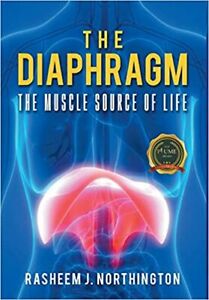
THE LATEST | CAMPUS EVENTS | NEWS | COMMENTARY | BEST OF WFTU
Five Towns College Adjunct Professor and Author, Rasheem J. Northington, breaks down the relationship between these critical body functions in a special feature for the FTC Record.

The function of the thoracic diaphragm has the potential and capability of increasing the efficiency of the kidneys by way of increasing their efficiency of filtration.
The kidneys are the organs that are responsible for removing wastes that come from natural metabolic reactions in the body, as well as toxins, excess fluid, excess ions including acids and other substances that serve no useful purpose in the body. The excess accumulation of wastes in any system decreases the efficiency of the system and with living systems such as humans, the accumulation of wastes in the body can also negatively impact health. It is important to have healthy working kidneys in order to promote good health in the body, as the kidneys would promote good health by keeping the level of wastes in the blood stream low enough so that they do no appreciable harm to health. Basically, the kidneys act as a filter for the blood.
Simply put, in the kidneys there is a filtration membrane. This filtration membrane in the kidneys is called a glomerulus, there may be a million of these. This glomerulus is a ball of capillaries and capillaries are blood vessels that are permeable to blood plasma which is the water portion of the blood containing dissolved solutes. Capillaries are however impermeable to plasma proteins. Now these capillaries in the kidneys are responsible for the filtration of the blood and they are positively influenced by a hormone called atrial natriuretic peptide or (ANP).
Breaking the words down, “atrial” is referring to the right atrium of the heart. The right atrium of the heart, which is one of the four chambers of the heart, is the chamber of the heart that receives the venous blood return from the vena cava. The word “natriuretic” broken down; the “natri” part of the word means salt and “uretic” relates to excretion and “peptide” is a small protein. So, the atrial natriuretic peptide is a small protein released from the heart cells of the right atrium that produces a positive effect on the kidneys and relates to salt excretion.
Now it is this peptide (ANP) that produces a positive effect on the kidneys. The positive effect that this peptide has on the kidneys function is that it stimulates the kidneys to increase their efficiency. More specifically, the peptide stimulates the kidneys to increase their efficiency by the effect that it has on the capillaries in the kidneys that are responsible for filtration. ANP increases the efficiency of the kidneys by maximizing the surface area of these capillaries that are available for filtration. This maximizes the filtration and the cleansing of the blood by these “glomerular” capillaries, resulting in an increase of the filtration rate. The filtration process cannot be any more efficient than the availability of its filtration membrane meaning, its capillary availability. In consequence more water is filtered along with a greater amount of solutes that would have a greater chance being released or excreted rather than remaining in the blood stream.
When this peptide (ANP) is not present, the surface area of the capillaries is then restricted (by mesangial cells) which then reduces the surface area of the kidneys’ filtration capillaries, which then reduces their rate of filtration. This prevents the kidneys from being able to filter or remove necessary substances (ions, acids, wastes, toxins) from the blood at its most optimal rate or capability.
This peptide (ANP) is released by the heart muscle cells of the right atrium. The stimulus that influences the heart cells of the right atrium to release this atrial natriuretic peptide (ANP) is an increase in the stretching of the heart cells of the right atrium, creating an increase in something called “stroke volume”. Keep in mind, blood only returns to the heart by way of entry into the right atrium from the veins or vena cava. Now, this increase in the stretching of the heart muscle cells of the right atrium is accomplished by an increase in the volume of blood that returns to the heart by the veins. This increase in blood volume received by the heart triggers the release of atrial natriuretic peptide which then travel to the kidneys.
Now, in my published book titled The Diaphragm-The Muscle Source Of Life. I discuss how a full or maximum voluntary contraction of the diaphragm increases the amount of blood returned to the heart via the right atrium as opposed to the normal involuntary contraction of the diaphragm. This greater contraction of the diaphragm compresses abdominal veins (vena cava), pushing the blood that is in them into the decompressed thoracic veins, which are veins in the chest, and then into the heart, all while the heart is beating at a relatively slower rate. This slower heart rate allows more time for blood to fill up the right atrium.
This increased volume of blood returned to the heart will cause the heart cells of the right atrium to stretch more, therefore stimulating the release of the atrial natriuretic peptide (ANP) from the heart cells of the right atrium which will then influence the kidneys to maximize the surface area of their filtration capillaries, which in turn will increase their filtration rate and filtration efficiency. Therefore, full or maximum contraction of the diaphragm can influence the kidneys to increase their efficiency so you can now also understand that diaphragmatic deep breathing can also trigger the same response from the kidneys.

Professor Rasheem J. Northington
Upon recap it appears that the heart communicates with the kidneys and they work as a team in the moving and filtering of blood. When we voluntary contract our diaphragm beyond the involuntary contraction we then increase the volume of blood that returns to the heart. This increased volume of blood that is returned to the heart will be the volume of blood that will be ejected from the heart. Once the heart receives this increased volume of blood it will cause a stretching of the heart muscle cells, the heart will then alert the kidneys that there is an increase in the volume of blood to be received so then the kidneys prepare themselves to increase their capability of filtering this increased volume of blood efficiently.
So keep in mind, when you maximize the function of the diaphragm then you increase the efficiency of the heart, the increase in the efficiency of the heart then leads to the increase in the efficiency of the kidneys. Stated another way, if you maximize the function of the diaphragm, then you maximize the efficiency of the heart which then in term maximizes the efficiency of the kidneys.
Keep in mind that the diaphragm is situated to compress the vena cava that is the major vein that flows blood directly back into the heart by a direct attachment.
The Thoracic Diaphragm also seems to be a muscle that can be used to act as the body’s own natural diuretic aided by increased water intake as well. A muscle that is always available and readily doing its job. That I will explain how in my next program or article.
To hear WFTU Radio Host Sean Lanigan’s interview with Professor Rasheem Northington, visit the WFTU Radio Mixcloud page.



